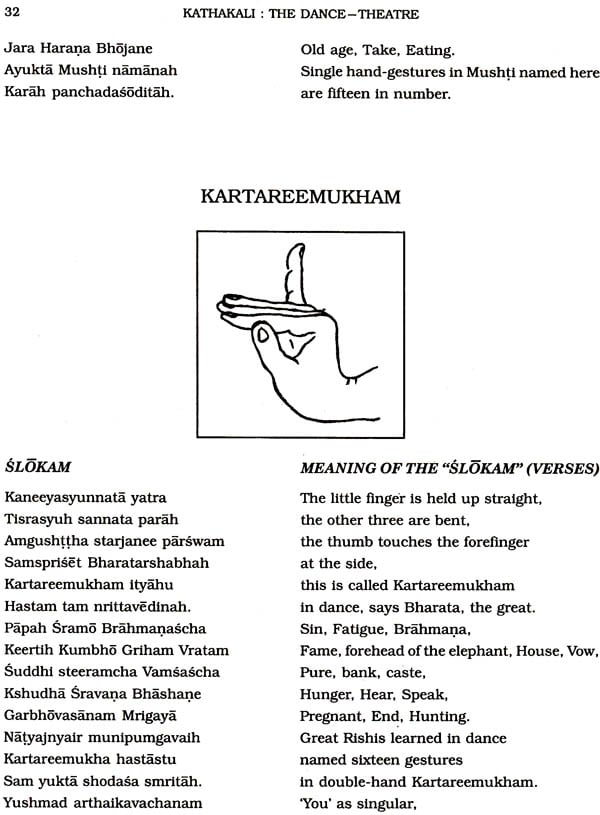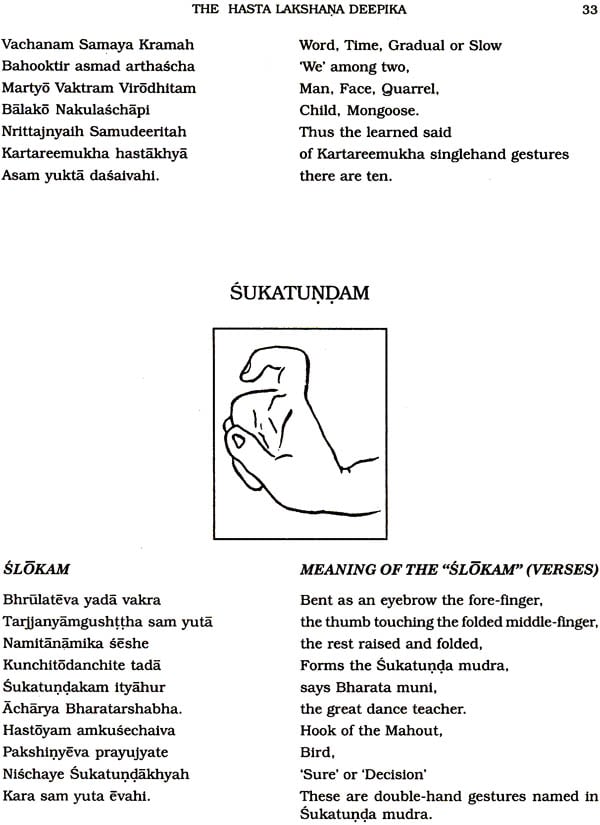
Kathakali The Dance-Theatre
Book Specification
| Item Code: | IDH467 |
| Author: | Kalamandalam Govindan Kutty |
| Publisher: | THE ASIATIC SOCIETY |
| Edition: | 2004 |
| Pages: | 77 (Color Illus: 8, B & W Illus: 8) |
| Cover: | Hardcover |
| Other Details | 9.6" X 7.2 |
| Weight | 330 gm |
Book Description
Kathakali the Dance-Theatre, a detailed treatise by Govindan Kutty is probably the first of its kind by a Kathakali actor. It contains all the essentials necessary to a serious student of Kathakali as well as easy stepping stones for the uninitiated to explore the wonderful world of this dance-theatre.
The guide to pronunciation is path breaking and should be useful to readers outside Kerala in correcting common but accepted errors.
The detailed list o ornaments, the exhaustive tala notation guide the Hasta Lakshana Deepika in Roman script as well as in English translation are evidence of the author's sincerity and aptitude for detail.
Kathakali's scientific sign language system should achieve wider understanding and popularity on the reading of this book.
And Kathakali teachers as well as students should realize the importance of studying & teaching the Kathakali technique instead of merely concentrating on its grand costumery after studying this book.
In fact this book should go a long way in supporting the spread and survival of Kathakali as an art form outside Kerala.
Kalamandalam Govindan Kutty was born into the Kathakali tradition, being the descendant of a family of eminent Kathakali actors.
Since the age of seven he has been a stage performer taking part in his school anniversary productions and his entry in 1940 into Kerala Kalamandalam was a foregone conclusion. Graduating in 1949 with the blessings of Vallathol he embarked on a successful career of both performing and teaching. He has been a member of Mrinalini Sarabhai's Darpana Dance Troupe, a Reader in the Dance Department of Rabindra Bharati University, an Examiner of Visva Bharati University, and the founder of Kathakali Art Centre, Calcutta.
With his wife Smt. Thankamani Kutty he has set up the renowned Kalamandalam Calcutta, the training ground for many successful Bharatanatyam Kathakali and Mohiniattam dancers.
Shri Kutty is now absorbed in the task of examining, researching and thinking on the rich tapestry of experience that he has gathered over a lifetime of hard work and translating it into a coherent, and usable form for students and lovers of dance.
Kathakali has always been and always will be his first love.
This book is his first work in English and the painstaking product of a deeply philosophical mind.
India has a rich heritage in classical dance. Various dance styles or dance forms have developed and are currently practised in different parts of the country. These Indian Classical Dances are mostly very ancient but over the centuries they have become assimilated with many other styles and dance forms. Thus. in Kerala a variety dance form has been in practice from ancient times. Kathakali is a very fine blend of these traditions. The chief features of Kathakali dance are Angika and Satvika Abhinaya. Aharya comes after this.
The author of this book. Govindan Kutty. who is well established as 'Guru' in this particular dance form. Kathakali. has in this book. ably and thoroughly dealt with the subject. In doing so he has placed himself as a 'Guru' and as such he has started by providing a guide to pronunciation of the language that he has used in his book. This has followed by tracing the history of this dance form highlighting changes in the style over centuries. Even though Kathakali is becoming popular day by day there is not sufficient literature available on the subject.
The Asiatic Society. therefore. takes pleasure in offering this book to the concerned scholars and performers (both teachers and students) and hopes this will be very useful in further popularising this particular dance form not only in our country but in countries abroad where more and more and day by day Indian Classical Dance and Music are being appreciated.
Indian Classical dance forms constitute a significant segment in India's cultural heritage and need to be studied and practised for further excellence. Kathakali is one such classical dance form originated in South India and subsequently became popular all over India and abroad. Sri Govindan Kutty , who mastered the finer nuances of Kathakali dance form and put it on a high pedestal through the Guru-Shishya tradition, has written the present volume as a guide for posterity.
I have great privilege in presenting to the students and enthusiasts of Kathakali, the reprint edition of ‘Kathakali-the Dance Theatre’ by Sri Govindan Kutty with the hope that this comprehensive study of Kathakali Dance form would go a long way in further rekindling interest.
I was born on 13th November, 1927 in the Southern tip of India, in a little village called Kuruvattor in the district of Palghat, Kerala State. In this same state was born the well known poet of Malayalam literature, the late Vallattol (Vallathol) Natayana Menon. His greatest contribution was the creation of the world famous institution of south Indian classical dances, the Kerala Kalamandalam.
It was my good fortune that I was able to become not only acquainted with but to remain under the watchful, loving eyes of such a great personage. How did this come about?
My maternal grandfather, the late Kantappa Kurup, and my late father Kuruvattoor Meletil Kunhan Nair, were both established Kathakali artistes. In April, 1932 when my father died he was just fortysix years old and I a mere four. Poet Vallattol, being a patron of the art of Kathakali was fond of my father. He was also a believer in profession being handed down through lineage. He decided, that of my father's two sons, atleast one should be admitted to Kerala Kalamandalam to study Kathakali dance.
However, our guardian after my father's death, my maternal uncle the late Kunhi Krishnan Nair was not a lover of Kathakali. He informed Poet Vallattol's messenger that he could not think of sending his elder nephew to Kerala Kalamandalam and even for the younger, he would wait until the boy was a little older. Poet Vallattol, indefatigably continued to send his messenger before admissions, every year. Ultimately, when I was studying in the seventh class my uncle was more or less reconciled to the idea, and I joined Kerala Kalamandalam. The rule however, was that a new entrant would have to be admitted before he completed twelve years of age. Though I was already thirteen, Vallattol's interest in us saw me through. I remained in Kerala Kalamandalam from 1940 to 1949. During this time I was fortunate to have been taught by several well-known Gurus among whom were Pattikkantoti Ramunni Menon, Kalamandalam Krishnan Nair, Katampur Gopalan Nair, Mani Madhava Chakkiyar and Kavalappara Narayanan Nair.
After, graduating from Kalamandalam in April 1949, I remained at home for four months pondering over my future. Luckily, I received a letter from the Poet stating that he had a request from the famous Bharatanatyam dancer, Tara Chowdhury for a Kathakali dancer for her dance troupe.
Since I was well versed in Hindi and English he had recommended my name and I was advised to meet her in Madras. Meanwhile, my uncle had passed away and my elder brother had assumed control of the household. With his and my mother's permission I left for Madras, I was there for nearly three months. However, finding the job unsuitable I left for Ahmedabad and joined Mrinalini Sarabhai's Darpana Troupe, This was in October 1949. I remained with Darpana, touring many countries life CEYLON. EGYPT, LEBANON, BRAZIL, URUGUAY, ARGENTINA, CHILE, PERU, ECUADOR, COLOMBIA. PANAMA, VENEZUELA. PUERTORICO, CUBA, MEXICO, U.S.A., FRANCE, ENGLAND, BELGIUM, HOLLAND, SWITZERLAND, EAST GERMANY, ITALY and giving many performances till 1955. I left Darpana in early '55 to pursue Kathakali independently. I returned to Kerala and having gathered a few students proceeded to tutor them in this vibrant art form.
This life continued for a few months. Meanwhile, an old student of mine and a member of Uday Sankar's troupe, Krishnan Nampootiri, wrote to me several times urging me to come to Calcutta as I was well versed in several languages and to work for the popularization of Kathakali outside Kerala. He himself was eager to begin his formal Kathakali training again. Though, initially hesitant about accepting his offer, eventually I agreed.
July 1955 saw me in Calcutta. As promised, Krishnan Nampootiri endowed me not only with the responsibility of the dance section of the Calcutta Malayalee Samajam but, also enrolled himself as my student. Thus began my teaching life in Calcutta. In January 1962 I joined as a teacher the Academy of dance, Drama and Music, Government of West Bengal. Gradually it became Rabindra Bharati University in May, 1962 and I retired from there as a Reader in December, 1922.
Many students have come and gone and forty-three years have passed in Calcutta. I have also gained in experience through touring for performances in JAPAN and BANGKOK (THAILAND) in the year 1983, and ENGLAND, FRANCE, and WEST GERMANY in the year 1985, in ENGLAND again in 1987, and as a Guest Professor for the Threatre Department, Giessen University, Germany in 1994 and in 1996 during their Summer-Terms.
Having garnered so much of experience and knowledge as a teacher and performer of Kathakali, I wrote a book, "Kathakali Nrityer Rooprekha" in Bengali for the Benefit of my students and regional art-lovers in the year 1992. This was widely accepted and appreciated.
With due respect to the request of my friends and well-wishers, and for the benefit of a wide range of art-lovers, I took up the task of writing and publishing this book, in English.
Since various schools of this art are in existence, one may have differences of opinion with what has been written by me but, I hope this would not detract from the usefulness of this book for the students and lovers of Kathakali.
The support and encouragement of Prof. Anil Sarkar, Dr. Pabitra Sarkar, The Asiatic Society and the untiring efforts of my disciple Ms. Sunita Chowdhurie in Helping me to write made it possible for me to bring out this book.
| Foreword to The Reprinted Edition | v |
| Foreword To The 1st Edition | vii |
| Preface | ix |
| Guide To Pronunciation | xiii |
| Chapter I | |
| The Beginning of Kathakali | 1 |
| Chapter II | |
| The Development | 5 |
| Chapter III | |
| Poorvaranga Vidhanam (The preliminaries of a play) | 8 |
| Chapter IV | |
| The Stage, Make-up and Costume | 11 |
| Chapter V | |
| Natanam | 16 |
| (a) Nrittam 16 | |
| (b) Natyam 22 | |
| (c) Nrityam 25 | |
| The Hasta Lakshana Deepika (The Lamp of Hand Gestures) | 27 |
| Life Sketches Of Some famous Kathakali Actor-Dancers | 57 |
| Epilogue | 60 |
| Index | 62 |







